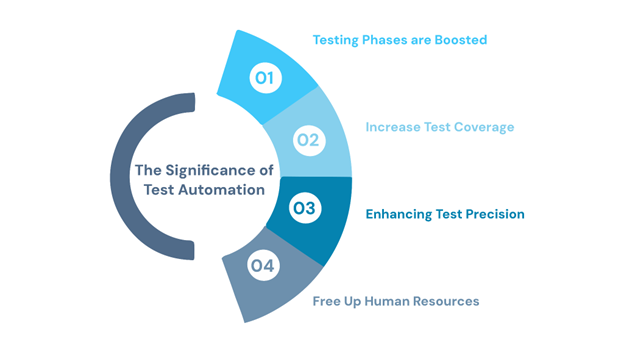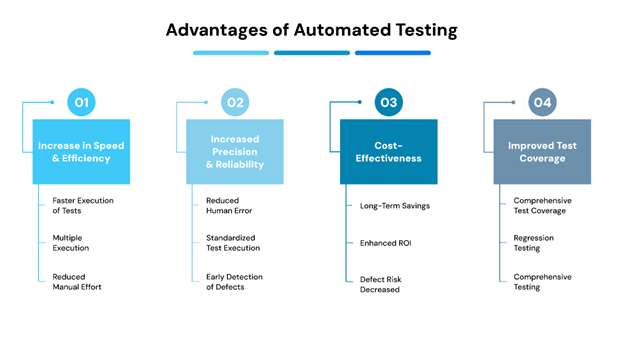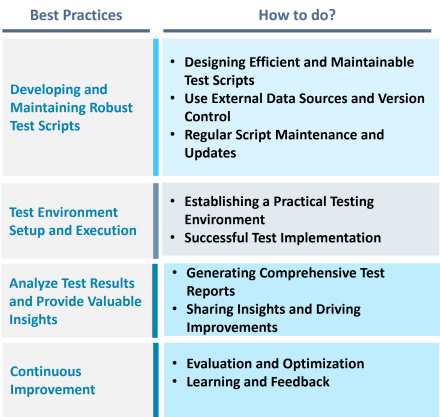In software development, delivering high-quality products efficiently and quickly is critical to sustain in a competitive market. Missing deadlines and delays in the software testing process, makes it challenging for organizations to maintain high productivity and quality. Software failures can severely impact quality, leading to a compromised user experience and adversely affecting the organization’s reputation
Then, how can organizations ensure consistent quality and reliability while adapting to faster development cycles?
Automation transforms software testing with speed, accuracy, and supreme efficiency. By integrating automated testing into the development process, businesses can enhance agility and reliable performance while reducing time-to-market.
In this regard, test automation has become an effective tool for transforming how you test software. As per Gartner reports, about 60% users believe that automating software testing can improve quality.
In this blog, let’s find out how we can optimize software testing productivity and efficiency using automation.
What is Software Testing Optimization?
In software testing, optimization is adjusting testing procedures to get quicker findings, make better use of available resources, and raise the product’s overall quality.
Finding a balance between the three main testing pillars of quality, cost, and time is the primary goal of optimization.
The test coverage and efficiency can be increased by focusing on high-risk areas and reducing redundant tasks by improving testing procedures, automation, and test case selection.
Software testing optimization covers several topics: automated testing, defect detection, test data management, and test case prioritization. Optimization lowers the time and expense of fixing bugs later by ensuring that every test case contributes value and identifies possible problems early in the software development lifecycle (SDLC).
Let us explore the importance of test automation in boosting software testing productivity.
The Significance of Test Automation
Although manual testing is used in some testing scenarios, it is frequently time-consuming, subject to human mistakes, and has scalability issues. Several firms use automation to overcome these challenges and improve their testing processes.

Employing tools and scripts, organizations can test cases using automation procedures to perform activities automatically:
- Testing Phases are Boosted: Automation helps in speeding up the testing process, allowing teams to run multiple tests in a shorter duration.
- Increase Test Coverage: By automating the process, all essential features are tested to assure performance, quality, and dependability.
- Enhancing Test Precision: Automated tests produce more accurate and reliable results because they are less likely to make mistakes.
- Free Up Human Resources: By automating repetitive processes, testers may focus on more complex and strategic aspects of testing, such as creating test cases and doing exploratory testing.
With that, let’s examine the specific advantages of automated testing and how it impacts overall testing productivity.
Advantages of Automated Testing
Automated testing has several benefits and is essential for advanced software development. Here are a few benefits of automated testing:

- Increase in Speed and Efficiency: Automated testing accelerates execution, allows simultaneous test runs, and reduces manual effort, enabling focus on strategic tasks.
- Increased Precision and Reliability: Automation minimizes human errors, ensures consistent test execution, and identifies defects early in the process.
- Cost-Effectiveness: Offers long-term savings, enhances ROI, and reduces defect-related costs through early detection and prevention.
- Improved Test Coverage: Enables comprehensive and regression testing with broader scenarios and extreme conditions that are challenging to achieve manually.
With these advantages of automated testing, let’s see how it stacks up against manual testing and where it truly stands out. Get more insights from our blog on Automated Tests and Its Types
Manual Testing Vs Test Automation
Here’s what you should know about manual testing and test automation:
| Aspect | Manual Testing | Test Automation |
| Speed | It is slower, especially for repetitive or large test cases. | Faster, as tests can run automatically and repeatedly. |
| Cost | Higher in the long run due to the need for manual effort and frequent retesting. | Initial setup costs are higher, but long-term costs are lower as tests run automatically. |
| Efficiency | It is less efficient, as it requires testers to execute tests each time manually. | It is highly efficient for repetitive tests and saves time on large test suites. |
| Accuracy | Prone to human error, especially in repetitive tasks. | It is more accurate, eliminating human error, but poorly written scripts can impact it. |
| Complexity of Tests | Suitable for tests that require human judgment, such as exploratory or usability testing. | Best for repetitive, regression, and load tests where predefined outcomes are expected. |
| Test Coverage | Limited coverage due to time and resource constraints. | Can cover many test cases, including complex ones, without significantly increasing time. |
| Flexibility | Flexible, as testers can quickly adapt and explore unexpected issues. | Less flexible; scripts need to be rewritten if there’s a change in the application. |
| Maintenance | Requires testers to update or repeat tests as the application evolves manually. | Requires ongoing maintenance of scripts, especially when there are frequent changes to the codebase. |
| Use Case | It is ideal for small projects, one-time tests, or testing that requires subjective evaluation. | Best for large projects, regression testing, repetitive tasks, and continuous integration. |
| Skill Requirements | Requires skilled testers who understand the software’s functionality and user behavior. | Requires knowledge of automation tools and scripting languages. |
| Reporting | Manual test reports are prepared by testers, which can be time-consuming. | Automated tools generate reports quickly, often with detailed logs and error tracking. |
Now that we’ve seen the key differences, let’s explore how you can successfully implement test automation in your organization with a step-by-step guide.
Watch our webinar on
Gen AI Future of Software Testing
Implementing Test Automation: A Step-by-Step Guide
The testing process can be significantly accelerated and accuracy increased using test automation. This is a detailed guide in successfully implementing test automation:
1. Establish Your Objectives and Goals
Define the purpose of automation—whether to reduce human error, increase test coverage, or speed up regression testing. Specific objectives help identify suitable tools and methods, prioritizing the most critical tests for automation.
2. Pick the Correct Tools
Select automation tools based on application complexity, tech stack, and team skills. Popular options like Selenium, Cypress, or Appium offer flexibility, while frameworks like JUnit or TestNG are great for complex applications. Ensure tools integrate well with CI/CD pipelines.
3. Determine Which Test Cases Need to Be Automated
Not all tests should be automated. Focus on valuable, repeatable, and stable scenarios, such as regression, smoke, and sanity tests. Only automate frequently modified tests if they are crucial to the application.
4. Establish an automation framework
Create an automation framework to define the structure and rules of your test scripts. Consider frameworks like linear scripting for simplicity, modular for maintainability, data-driven for increased coverage, or keyword-driven for predefined functions. For instance, popular frameworks like Pytest (known for its simplicity and scalability), Robot Framework (ideal for keyword-driven testing), and Selenium-based frameworks (for web application testing) can streamline the process.
5. Create Test Scripts
Develop test scripts with a focus on reusability and modularity. Use assertions to verify expected behavior, handle exceptions gracefully with try-catch blocks, and incorporate logging for easier troubleshooting.
6. Use Tools for Continuous Integration (CI)
Integrate your tests with a CI/CD pipeline to automate execution with each code change. This enhances the developer feedback loop and aids early flaw detection, with automatic triggers for running tests.
7. Conduct and Track Tests
Regularly run automated tests to evaluate effectiveness. Monitor for script errors and false positives/negatives and use dashboards or reports to track trends and success over time.
8. Continue to Update and Maintain Tests
Update tests to reflect new features or changes in functionality. Regularly review and refine scripts, adding new cases, removing outdated ones, and adjusting to changes in the application.
9. Examine and Enhance
Analyze test results post-automation to identify improvement areas. Look for trends in test failures and consider enhancing your test suite by adding features or edge cases.
10. Scale Automation on Demand
As your project grows, scaling test automation is vital. This may involve expanding test scope, adding complex scenarios, or incorporating additional tools like security or performance testing frameworks.
Best Practices for Test Automation
Ensure your automation framework is adaptable enough to expand with your team and product. Here are some best practices to maximize the effectiveness and efficiency of your test automation efforts.
Effective test automation relies on robust test scripts and a well-prepared environment. Scripts should be modular, parameterized, and regularly maintained. A properly configured test environment ensures accurate results, while efficient execution strategies, including automation and comprehensive reporting, enhance reliability and speed.
Continuous improvement is vital for sustaining test automation. Analyzing test results helps identify critical defects, while collaboration between teams ensures timely resolutions. Regular evaluations and feedback loops keep the testing framework efficient and adaptable, enabling organizations to deliver high-quality software in alignment with Agile and DevOps practices.
Conclusion
Software testing productivity must be maximized by automation in today’s fast-paced development environment to produce high-quality software on time. With automated testing, you may meet deadlines without sacrificing quality since it expedites procedures, lowers errors, and increases test coverage.
Continuous improvement is the key to success; your team can increase testing efficiency and accuracy with the correct tools and techniques.
Calsoft’s test experts help customers in building and executing test automation and controlling the test results to deliver quality software within time and budget.







